Hildre-Reiten History¶
Internal Links¶
Links are provided of the following types:
ADDITIONAL INFORMATION and BLUE LINKS WITHIN TEXT: These links are provided to alert the reader to supplemental information or stories pertinent to the present discussion.
PHOTO: These links connect you to pictures or photos of significance to the discussion.
SOURCE: These references are provided to credit the sources of the information provided in the text which follows, the text may not include the entirety of the original source discussion.
In each case clicking on the link will connect you to the information.
Selecting the upper left return arrow will return you to previous pages.

Preface¶
Read the following sections of Hildre-Reiten History for background information including a very concise summary of recent Nowegian history and the common history of the Reiten and Hildre families in the area of More og Romsdal, Norway. This section is identical to the first section of the Hilde Family History, so if you have previous read it there, you may prefer to jump ahead to more specific information beginning in the section labeled Reiten History.
Note: Sections listed with all capital letters in the Table of Contents are from The Reiten Family Book by Sister Paula Reiten, OSB 1984.
Norwegian History¶
Introduction
What is known today as Norway (or Norge to its own inhabitants) began as Norvegr, meaning 'the way north'. Following the gradual unification of the country from various petty kingdoms it came to be called 'Noregr'. During the Middle Ages this gradually became 'Noreg' before ending up with the current 'Norge'. Another, rarer name during the Viking period was 'Norrmannaland', land of the northmen, but this was used mainly by foreigners.
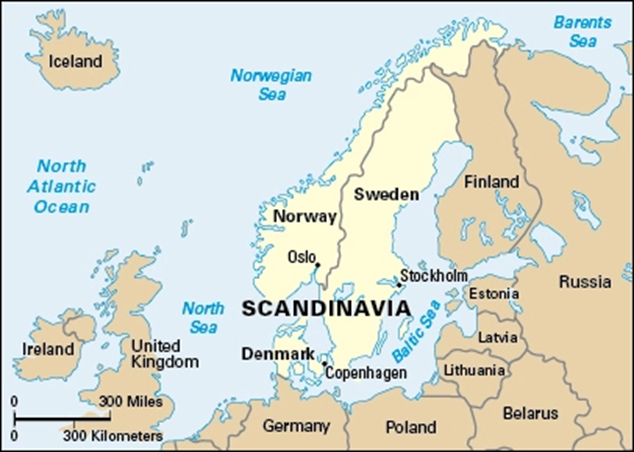
The Hildre and Reiten families originated from what is now called the "county" of Møre og Romsdal identified in the map below including the cities of Molde and Alesund. The area that became known as Hildre is located on the coast near Alesund.
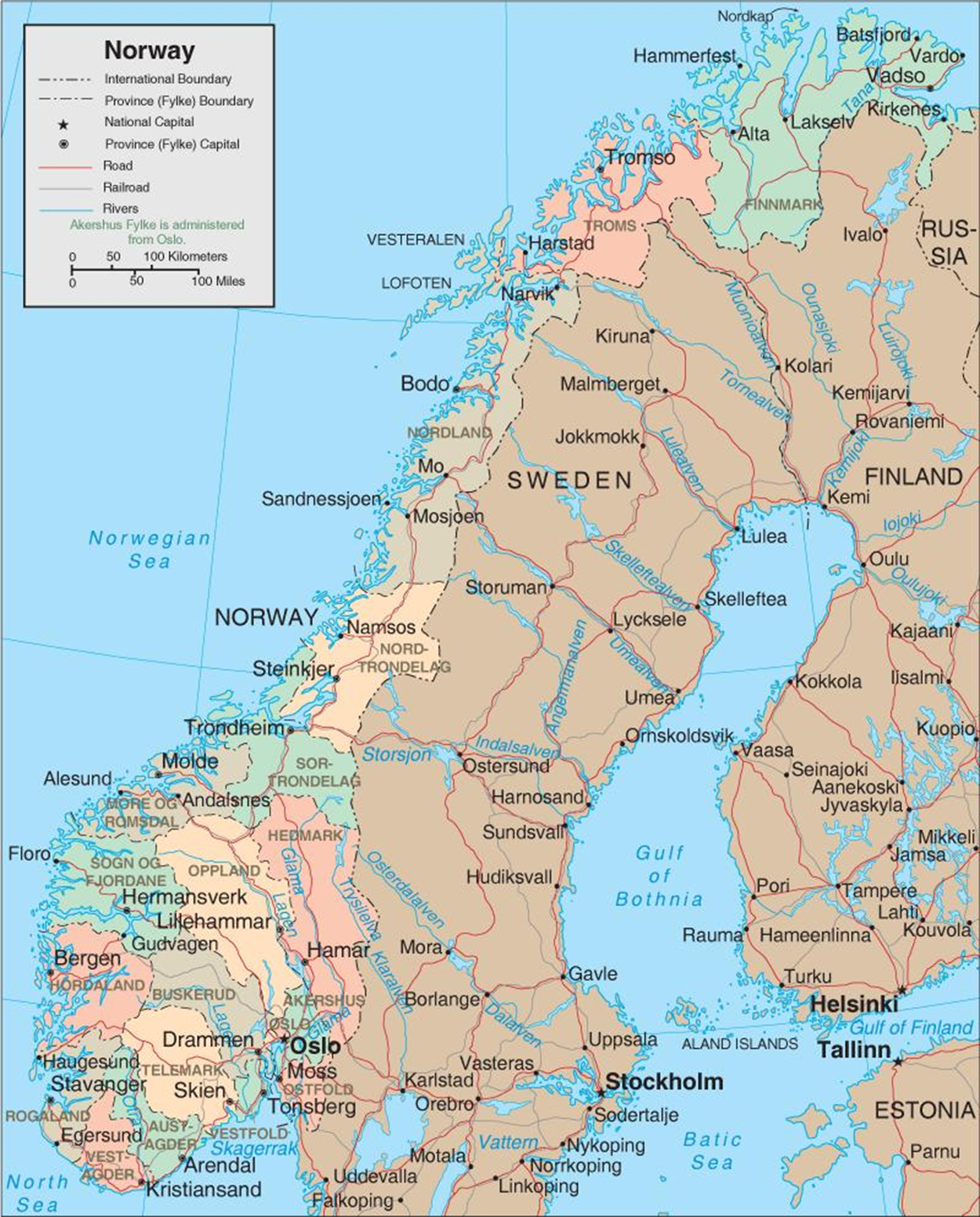
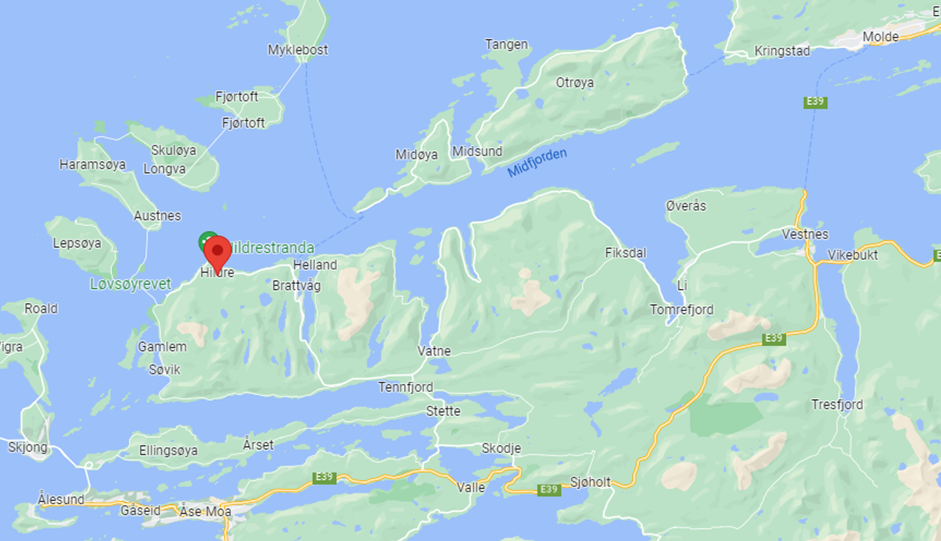
Hildre location relative to Alesund (lower left) and Molde (upper right)
Following is a very concise timeline of the history of Norway with a few sections dealing more specifically with Møre og Romsdal (in italics).
500 BC – 750: Iron Age in Norway
During the centuries prior to 100 AD the Hallstatt culture of Northern Europe expanded its influence as well as Germanic languages into southern Scandinavia.
100 AD - 450 AD: The period of Roman Empire expansion enabled significant trade and cultural exchange between Scandinavians and northern Germanic tribes. Trade including coins, vessels, glass objects, buckles and weapons as well as luxury goods like gold and silver began to increase. The period became known as the Roman Iron Age.
550 AD - 750 AD: Some powerful farmers at that time became regional chieftains and their power increased as other Germanic tribes migrated northwards and local farmers wanted protection the chieftains could provide.
750 AD – 1100 AD: The Viking Age in Norway
An era of exploration and expansion. In addition to being warriors, these Norsemen created social institutions, oversaw the conversion to Christianity and left a big impact on European history.
793 AD: The beginning of the Viking Age is often regarded as the raid on Lindisfarne in the British Isles.
872 AD: Icelandic historians believe Harald Fairhair became the first King of Norway. He is said to have unified Norway.
Møre og Romsdal The identity and history of the early kings of Møre and Raumsdal originate from Norse sagas and have little representation in historical documents.
Møre and Raumsdal Legends
According to legend, the land of Raumsdal is named after Raum the Old, son of king Nor, legendary founder of Norway.
Raum the Old married Bergdis (a giant’s daughter)
Child of Raum the Old: Jøtunbjørn ('Giant-bear') the Old Raumsdal
Child of Jøtunbjørn ('Giant-bear') the Old Raumsdal: King Raum
Child of King Raum: Hrossbjörn
Child of Hrossbjörn: Orm Broken-shell
Child of Orm Broken-shell: Knatti
Children of Knatti: Thórolf and Ketill Raum
Based on legend, some of Thórolf’s descendents were among the first settlers in Iceland and the son of Ketill Raum who was called Ketill Flatnose was a prominent Viking chieftain (circa 850) credited with conquering the Hebrides and the Isle of Man. The Norwegian king, Harald Fairhair, appointed him the ruler of these islands, but when Ketill failed to pay tribute to the king he was outlawed. Ketill Flatnose and his family left Norway for Scotland, then Ireland, where his daughter, Aud the Deep-Minded married Olaf the White, king of Dublin. Aud would later move to Iceland where she began that country's shift to Christianity.
In the early nineth century King Eystein "Glumra (the Noisy)" Ivarsson ruled neighboring Oppland.
Child of King Eystein "Glumra (the Noisy)" Ivarsson: Ragnvald Eysteinsson (830–890) (Norwegian: Ragnvald Mørejarl), became jarl (earl) of Møre and close associate of King Harald Fairhair
Ragnvald Eysteinsson (830–890) married Ragnhild Rolfsdaughter.
Children of Ragnvald Eysteinsson: Hrolf Ganger and Tore Teiande. Tore Teiande became Earl of Raumsdal after his father’s death. Some historians believe that Hrolf Ganger was the famous Viking known as Rollo, who became ruler of Normandy and was the direct ancestor of William the Conqueror.
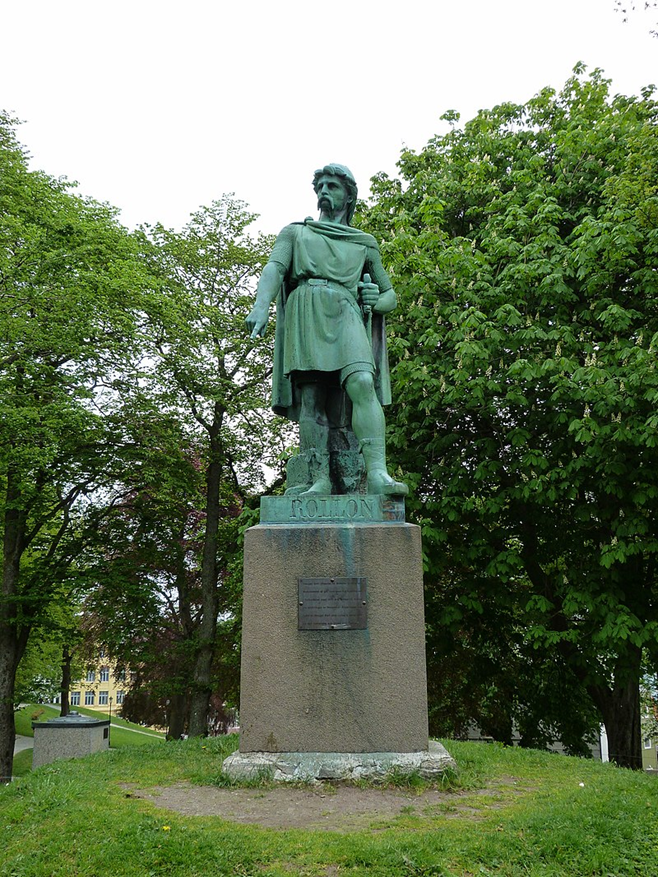
A statue of Rollo in Ålesund, Norway By Delusion23 - Own work, CC BY-SA 4.0, SOURCE
900 AD: Battles continue in Britain over land and power, while Vikings sail into France and along the Mediterranean.
981 AD: Expelled from Norway and Iceland, Erik the Red settled in Greenland with 25 ships, people and goods. More than 3,000 Vikings were said to be living on Greenland as farmers at one point. Vikings also discovered Newfoundland after being blown off course on a voyage to Greenland.
995 AD: The founder of Trondheim, Olav Tryggvason built the first Christian church in Norway.
1030 AD: Norway's Christian King Olav Haraldsson was defeated in the Battle of Stiklestad. Churches and shrines to Saint Olav were built in his honor across Europe. However, some historians doubt the authenticity of the battle.
1100 - 1400 AD: Late Middle Ages
Many chieftains feared that Christianity would rob them of power, so it took centuries for the new faith to be fully accepted. For many years people practiced a blend of pagan and Christian rituals and beliefs.
1100 AD: Population increased drastically. Many farms were divided into smaller plots of land, with some landowners turning over their land to the King or church during tough times.
1130 AD: After almost a century of peace, ambiguous rules of succession led to a civil war.
1280 AD: Known as Norway's original ‘golden age', the late 13th and early 14th century was a peaceful time of increasing international relations.
1349 AD: Many communities were entirely wiped out as the Black Death arrived in Norway. The disease killed a third of the population within a year. The subsequent drop in tax income weakened the King so the church became more powerful.
1360 AD: The Hanseatic League took control of a lot of international trade via its establishment in Bergen.
1400–1800 AD: The Scandinavian Unions
The Kalmar Union was a personal union between Norway, Denmark and Sweden – which at the time also included much of modern Finland – under a single crown.
Møre og Romsdal: The towns of Åndalsnes, and Molde (red boxes below) became major trading centers around 1600, replacing Veøy (solid red marker) as the principal market town for the region. The red circle indicates the location of Hildre, Norway.
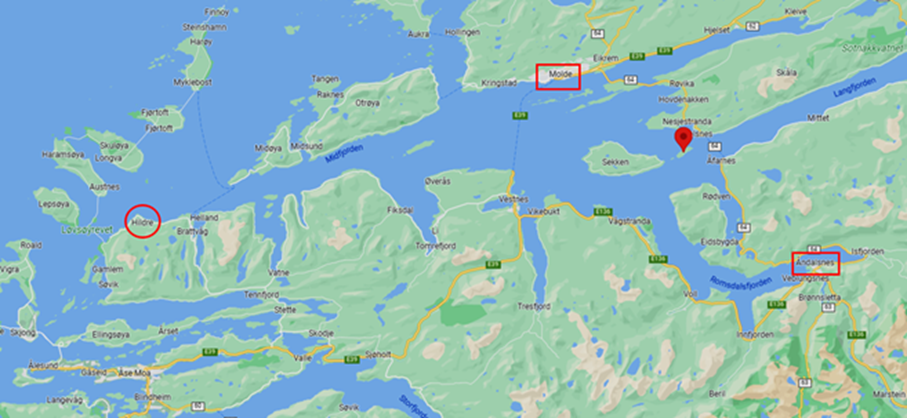
In the 1658 Treaty of Roskilde the Trondheim region of Norway was ceded to Sweden, down to the north bank of the Romsdalfjord. The Romsdal farmers defied the Swedish taxes and military conscription, and the Swedish governor was forced to send a full company of soldiers, and 50 cavalry besides, to collect taxes. Following the attack on Copenhagen and the city's successful defence, and the reconquest by Norwegian forces of Trondheim, the Treaty of Copenhagen in 1660 restored that province to Norway. The few months of experience with Swedish taxation and conscription left such a bitter taste that it strengthened Norwegian unity and patriotism, making resistance to Swedish invasions of Norway stronger over the next 80 years.*
1524–1814 AD. The Kalmar Union dissolved, but Norway remained in a personal union with Denmark. While the crowns were united, the two countries retained their own laws, currencies, and militaries. Norway was part of the Kingdom of Denmark-Norway. Following the defeat of Napoleon's troops at the Battle of Leipzig in October 1813, the Treaty of Kiel of January 1814 ceded Norway to Sweden.
1814 - 1905 AD: Norwegian Independence
1814 AD. There was a movement initiated to establish an independent nation which resulted in the signing of the Norwegian constitution at Eidsvoll.
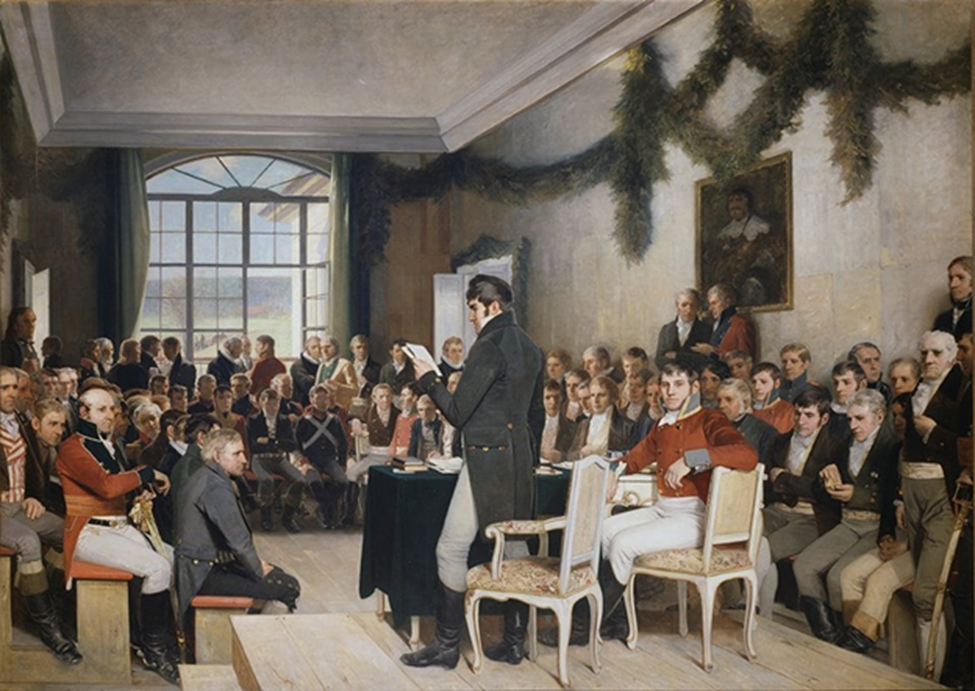
The 1814 constitution assembly. Painting by Oscar Wergeland. | Photo: Teigens Fotoatelier A/S - Stortinget cc pdm.
1814–1905 AD. Nationalistic aspirations were soon frustrated by Swedish victory over Norway in a brief war. To avoid further bloodshed, Norway entered into a personal union with Sweden, and the constitution was amended to form the Union between Sweden and Norway. While Norway was to keep most of its own institutions, the two countries were to share a common monarch and a common foreign policy.
Throughout the century improved hygiene and significant medical progress resulted in a drastic fall in child mortality and rapid increases in population. Many people moved to the cities and became part of a growing industrialization. From the mid-1800s onward, somewhere between 750,000 and 1 million Norwegians emigrated, primarily to North America.
During this period the building of roads and railroads improved communication and the movement of goods. The Norwegian communities were revitalized, and there was a political and cultural awakening.
1905 AD. Negotiations between the two governments eventually led to full independence. Sweden recognized Norway as an independent constitutional monarchy.
ADDITIONAL INFORMATION: Early Møre og Romsdal History
ADDITIONAL INFORMATION: Video: Norse Mythology Explained In 15 Minutes
ADDITIONAL INFORMATION:Videos: Scandinavian Folklore
The remainder of this Hildre - Reiten History and the text in the links for the Hildre Family and Reiten Family are taken from The Reiten Family Book researched and written by Sister Paula Reiten (1984). Genealogy listings in the text for both families was supplied, in part, from the Reiten Book (Outline sections in all capital letters) along with additional research.
INTRODUCTION TO HILDRE-REITEN HISTORY¶
The Reiten and Hildre families had lived in Norway for generations. When members of both families emigrated from Norway to the United States in the latter part of the nineteenth century, they were pulling up deep roots from one land and culture and transplanting them in another land and culture half a world away. This was no small undertaking and required strength and courage and vision. Following is a brief look at Norway and its emigration patterns, at what life was like in the new world in the 1880s, and a bit about the Reiten and the Hildre family roots in Norway.
NORWAY¶
Norway, the northwestern part of the Scandinavian peninsula, and the northernmost country in western Europe, is a long narrow coast country fringed by countless rocky islands. It faces west looking toward Greenland and the North American continent.
Though Norway covers an area of 125,180 square miles, not quite as much as North Dakota and Iowa combined, only about 10% of the land is habitable. About 3% of the land is arable; most of that, which is given over to small farms, is rocky soil. About 20% of the country is forestland, 4% is covered by lakes, and 75% is mountainous and unproductive. Norway, then, is a land of fjords, lakes, mountains, and glaciers. This terrain has determined the industries of Norway and shaped the destinies of its people. Over the centuries, Norwegians have engaged in farming, grazing, forestry, fishing, shipbuilding, and shipping, for it has been a seafaring nation. Now Norway is an industrialized country, though industrialization came late to Norway.
The 1980 census shows that Norway has a population of 4,078,900 - about that of the state of Minnesota. Most of the inhabitants of Norway are concentrated along the seacoasts; in fact, about 75% of the people live within ten miles of the sea, while 40% of the population is concentrated in or near Oslo. The north is thinly settled. Before industries settled into the larger cities and drew many from the rural areas, even a larger percentage of the people of Norway lived along the seacoasts on small farms or in villages. The Reiten and the Hildre families, as well as many of the families of others who emigrated to Petersburg, ND, in the latter part of the nineteenth century, were from Sondmore, a district on the western coast of Norway north of Bergen.
NORWAY EMIGRATION
Norway did not take part in the early colonization of North America for, as a subject of Denmark, it was not an independent state. But with the adoption of a new constitution on May 17, 1814, the right to emigrate was recognized. Then for about a hundred years, between 1825, when the sloop Restauration brought 52 Norwegians to America, and the 1920s when the United States enacted new laws which restricted immigration, hundreds of thousands of Norwegians emigrated to America. After a slow beginning, they soon began coming by the thousands year after year. By 1850, between 17,000-18,000 people had emigrated; in 1861 alone, 8,000 Norwegians left their homeland for the new world. Then during the Civil War, emigration slowed considerably. At that time, of the 44, 000 Norwegian immigrants living in the United States, between 4,000 and 6,000 served in the war.
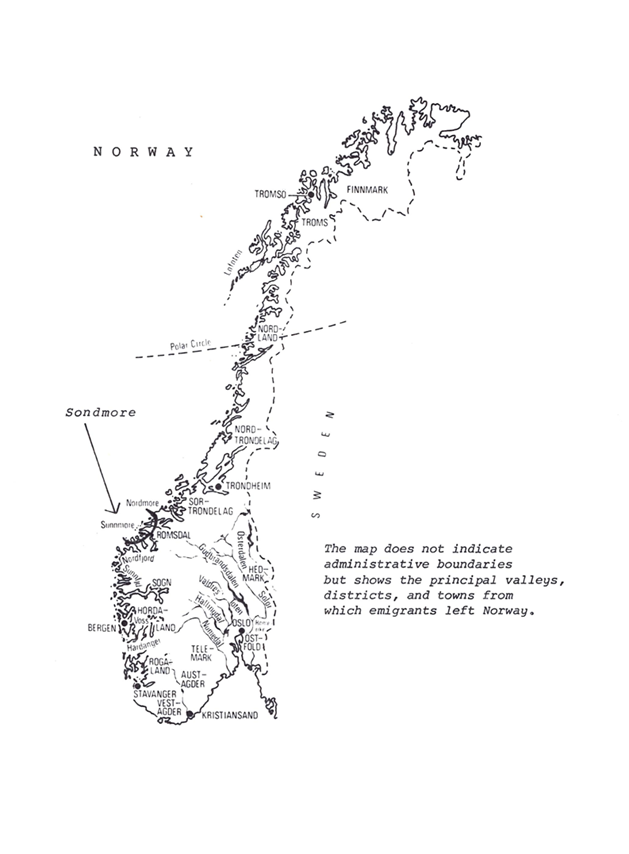
After the Civil War, there was mass emigration from Norway. In the 50 years between the Civil War and World War I, nearly 750,000 people left Norway. However, during that same time, the population of Norway was also growing - from 1,800,000 in 1865 to 2,500,000 in 1915. Between 1879-1893, when the Reitens and the Hildres and others from the Sondmore area emigrated to America, about 250,000 people left Norway.
At first most of those who came to the United States from Norway expected they would never see their homeland again. But from the 1880s on, the number of those who returned to Norway began to grow. Before long many emigrants realized they were not necessarily saying goodbye forever to their native land. After 1880, it was estimated that about one-fourth of all emigrants returned to Norway; in the 1920 census, Norway had 50,000 returned North Americans living there. Hans and Wilhelmine, too, were to try to return to Norway after many years in North Dakota.
By 1900, about 80% of the Norwegians in America were in six midwest states: Illinois, Iowa, Wisconsin, Minnesota, South Dakota, and North Dakota. In North Dakota, Norwegians were nearly 25% of the population, many of them living in rural areas and small towns. The U. S. Census, Norwegian Bureau of Statistics, in 1920 calculated that there were some I, 200,000 people of unmixed Norwegian descent living in the United States, almost half the population of Norway at that time, and another 700,000 were part Norwegian. And so, with this large number of people emigrating from all over Norway, there were few families in Norway that had not been affected by the migration fever. The emigration of people from Norway to the United States has been a significant part of Norway's history.
NORWEGIANS IN AMERICA
During the 1870s and 1880s when so many from the Sondmore area in Norway emigrated, the Dakota Territory was the goal for most of those looking for a new home. Land there had been opened for homesteading in 1863, and the recently completed railroads had made the territory accessible and rapid settlement possible.
These Norwegian immigrants came from a land of mountains and forests and small farms with rocky soil. After traveling thousands of miles across an ocean and half way across a great continent through populated areas, through hundreds of miles of forests in Wisconsin and Minnesota, and crossing the Red River, they arrived in the Dakota Territory. Many of these immigrants would have favored the fertile Red River Valley with its river and trees, but soon the land there was all taken. So, when they could, they chose land near brooks and creeks where trees grew - the areas that reminded them of their native land. But many, including Hans and Wilhelmine, had to reconcile themselves to the treeless, windswept prairie, the great green meadow, as it has been called. There they experienced the endless miles of flat grassland and the vast expanse of sky with prairie sunsets that have no equal. There may have been an austere beauty in its very immensity and flatness, but such terrain was totally foreign to them. They must have been awed by its bigness and its emptiness after the fjords of Norway with the sea and hills and mountains and forests and winding roads. The extremes of weather and temperature must have been shocking after the bracing but moderate climate of their native Norway.
For many of these immigrants, the dream of rich land of their own and the hope of prosperity and a happier future for their children had drawn them to America, the land of opportunity, which they had heard so much about, and this dream held them there. A person who was a cotter or tenant in Norway could be the owner of a large farm in America. In fact, one could own more land in America than there was in all of Hildrestranda, where the Reitens and Hildres lived.
Beginning in 1861, those who wanted land could buy it or secure it free from the federal government which gave away land for settlement under provisions of the Homestead Act of 1862 and the Timber Culture Act of 1873. Under the Homestead Act, any citizen or intended citizen 21 years of age could acquire ownership of up to 160 acres of land (a quarter section) by residing on it and cultivating a portion of it for five years. Under terms of the Timber Culture Act of 1873, a settler could also acquire 160 acres of land by planting 10 acres of trees on it. At the end of eight years, if there were 675 living trees on each of the ten acres, he could make final proof of title. There was no residence requirement.
The federal government also sold land. Under the Pre-emption Law, a settler who did not already own 320 acres in any state or territory could buy 160 acres for $1.25 an acre after living on the land for six months and making certain improvements. Pre-emption means the right to settle on and improve land for a time before buying it.
These three laws; Homestead Act, Tree Culture Act, and Pre-emption Law, set limits on the amount of land an individual might acquire. A settler might file on 480 acres, but not at the same time, for both the Homestead Act and the Pre-emption Law required residency.
However, though many people filed on government land, many never finished their claim. By 1895, only about 16,000 homesteaders in North Dakota who had filed original entries before 1890 ever made final proof of meeting the residence requirements, while only 8,000 of the settlers who made tree-claim entries ever proved up. Cash purchase of land from the federal government, however, was more successful. From 1871-1890, about 19,500 settlers bought land in North Dakota under the Pre-emption Law.
Usually the immigrants took out citizenship papers soon after they arrived, so they could put down stakes to make their claims. Some had to find work - digging canals, cutting timber, mining, working on farms - to bring in cash. Then they would clear the fields, break the sod, and begin to produce food and raise crops on their land.
Wherever they chose to homestead, the settlers needed water and shelter. For water, they tried to find a spring or a river, or would dig a shallow well. For shelter, they quickly learned to use whatever was at hand. If there were trees on their claim, they might build log houses. Or if their property had hills, they could burrow into the side of a hill and cover the opening with canvas or wood; the only sign of their hill home would be a chimney rising out of the top of the hill. These dugout homes were warm, but dark. But on the open prairie where there were no hills, pioneers would cut pieces of sod and lay them, much as a bricklayer lays bricks, to build a sodhouse. This house could have small windows
Fuel was often a problem on the treeless prairie. Many burned cow chips; others twisted grass for fuel. Food was less of a problem for it could be obtained by hunting ducks, prairie chickens, geese, and deer, and by fishing in the streams and rivers. Wild berries and plums were plentiful in the coulees.
It soon became evident that the Norwegian immigrants had brought much to this country. Those who emigrated to North Dakota were mostly of peasant stock: small farmers, small renters, cotters, and farm laborers, but they were not illiterate for in Norway, everyone learned to read and write. It was the bold and the adventuresome who left Norway where opportunities were limited, those who were intelligent, enterprising, ingenious, industrious, and courageous. They soon learned that pioneering in a new country was not easy, that it meant facing hardships and dangers, that it meant hard work and drudgery, but many were used to that. It also meant opportunities for courage, for optimism, for ambition, for energy and resourcefulness, for compassion. They soon became a hustling energetic people who took pride in their accomplishments. Just withstanding the rigors of long hard winters and long hot summers was an achievement which produced a sense of self-worth, for one had to be strong to survive.
Norwegian immigrants from specific locales in Norway tended to settle in clusters near each other where they were friendly and helpful to each other. Many emigrants from Sondmore were to settle in the Petersburg area. These Norwegian Americans soon created for themselves something of a little Norway in their communities. They built and attended Norwegian Lutheran churches, read Norwegian-American newspapers, organized and joined Norwegian societies and clubs, and even sent their sons and daughters to Norwegian-American colleges.
Yet they also learned English, became United States citizens, voted, ran for local, state, and national offices, and rubbed shoulders and did business with Americans of other nationalities. Most Norwegian immigrants were bilingual - using English for business and public contacts, and reserving Norwegian for home and family and more intimate personal experiences.
Their loyalties were dual, also. The ties that bound them to Norway were strong, for nearly all of them had family and friends who remained in Norway. Yet they were proud of their new land and of what they had made of it, and soon came to love it. Something of this pride in and love for North Dakota was captured by North Dakota's poet laureate, James W. Foley, in his poem, "Letter Home," which appeared in a special 1906 immigration edition of the Fargo Forum. This poem soon became a favorite for it expressed something of the mysterious lure and attraction that North Dakota, their new land, had for so many immigrants. Parents quoted it to their children, and the children memorized it in school.
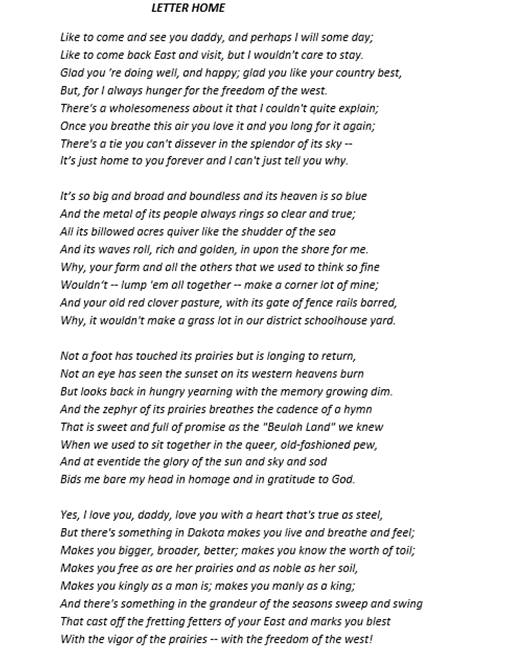
James W. Foley
PLACE NAMES IN NORWAY
Place names in Norway can be confusing, for there are many ways to express where one is from. The Reitens and the Hildres are from all of the following places:
HILDRESTRANDA, an area of rocky seashore or coastline (stranda), about 10 miles long, located about 20 miles north of the city of Aalesund. Ingward Reiten tells of his family coming from the farm of Reiten on the on the . . .
rocky coast known as HiIdrestranda . . . barren windswept spit of land jutting out into the North Sea, so windswept that no trees grew there. It was just rocks and peat lands, bush and heather, and the sea rolling in. Here they were all fishermen who also maintained small fields among the rocks where they grew barley and oats, potatoes and some hay, and grazed a few cattle and a few sheep on the sathers or summer pastures up in the mountains.
When the children were very young, they crawled down the rocky path to the sea where on calm days they could play in the surf and peer down into the mysteries of the sea bottom, or they could improvise a line and fish or watch the flocks of noisy swooping seagulls. In the summer there was the ever-present daylight, the golden, shimmering light when the sun rolled toward the horizon until it disappeared behind the island of Flem to reappear when it came by the island. The purple heather, the violas, and other wildflowers created a fairyland atmosphere. In winter, the darkness, the storms, the loneliness when the men were away with the fishing fleet, and above all the wind and the pounding sea caused both young and old to feel as if judgment day were at hand. Small wonder that sensitive souls were either wildly happy or deeply depressed.
REITEN, ALVESTAD, HILDRE, farms on Hildrestranda; there are many farms called Hildre. HILDRE is also a community.
ADDITIONAL iNFORMATION: Norway Maps
HARAM, an island not far from Hildrestranda. The church was located there and at one time, it was the center of government or parish. HARAM PRESTEGJELD, Haram Parish, included all of Hildrestranda and the surrounding districts. The Reitens and the Hildres are from the parish of Haram.
SONDMORE, similar to a county. Hildrestranda is in Sondmore.
MORE og ROMSDAL, similar to a large county or a district.
AALESUND, the largest city (over 40,000 population), and the largest fishing port in western Norway. As the crow flies, it is about 15-20 miles from Hildre to Aalesund, but with the winding roads around and through mountains, the distance is about 50 miles.
THE REITEN AND THE HILDRE FAMILIES¶
It is not easy to trace the Reitens and the Hildres in Norway, for family names would change as ownership of farms changed. The Haram Bygdebok (bygd = country, district, parish) an early history of the farms of Haram, includes an account of farm #26, Reiten, which was an old farm mentioned in the year 1600. For a time in the 1700s, it was a part of farm #27, Alvestad, until they were separated in 1771. It was farmed by cotters or tenants with life tenure who often had to pay as many taxes as if they were landowners. "With the assessment of 1771, it was ordered that the farm of Reiten should pay all ordinary and extraordinary taxes and one calf hide in conscription tax for naval defense." Before 1800 there was never more than one farmer on Reiten, which was owned by Borgund Parish from the middle ages until the 1800s. It seems that the king owned all the land in the middle ages; then, to finance his army, sold it to the churches. It is unknown how the families obtained possession of it after that.
However, Reiten was inherited by ANNA NILSDATTER (1789-1850), daughter of Nils Olsen of Synnaland, an only child, who married JETMUND OLSEN SYNNALAND, son of Ole Jetmundsen Helland, also from Synnaland. At that time, four farmsteads were in one group in Synnaland. When Anna and Jetmund moved to Anna's farm and took the name of Reiten, the old family relationship returned to the farm. They leased the farm for their lifetime from the Borglund Church. Jetmund Olsen and Anna Nilsdatter were the paternal grandparents of Hans O. Reiten.
Jetmund and Anna had at least three sons and may have had other children as well. The first son was Jetmund Jetmundsen Sonderland, born in 1800, who married Inger Myskje Harumsoy; they inherited the Arne-gard, the farm. Jetmund was a well-informed man who often visited the sick and the elderly and would read to them. The second son, Nels Jetmundsen (Sonderland) Grytten, was born in 1802.
A third son, OLE JETMUNDSEN ALVESTADREIT, better known as Reit Ola, born in 1805, was to become Hans's father. He and his wife, INGER (ENGE) SJURSDATTER AAKRE, had their own farm on Alvestad-Reiten. Reit Ola was considered the first layman or lay preacher of that district, apparently an adherent of the lay preacher/revivalist Hans Nielsen Hauge (1771—1824) who de-emphasized ritual and hierarchy and stressed holy living. Reit Ola gathered people in homes and conducted religious meetings. It was told that one Sunday morning, Ola walked from Alvestad to the Vatne Church and took part in the services. Afterward he talked to the people in the church yard, and then walked home to Alvestad. After being encouraged by the parish priest and with the blessing of the bishop, Reit Ola opened a weather station in 1870 on Haram; from there fishermen left to go fishing. No doubt it was from his father that Hans learned to read the skies to predict the weather. Reit Ola died in 1875 as a karman, a retired farmer who when he turned over the farm to his heir, was guaranteed a home and food for the rest of his life.
Ole Jetmundsen and Inger Sjursdatter had several children, among them, HANS KNUD MARTINUS OLSEN REITEN. According to Carl Alvestad, who worked for Peter I. Reiten many years ago, they had five sons and two daughters: Knute, Nels, Iver, Andreas, Hans, Anna, and Hellena. As far as is known, Hans was the only one of their children to leave Norway for a new home in America. However, their son Knute had three sons and one daughter who emigrated, while Iver had four sons who emigrated, all of them to the Petersburg, ND, area. Their son, Nels, had a whaling fleet that sailed great distances, even as far as the North Pole. On one of his trips, he and his crew found the remains of Amundson's plane which had been forced down 136 miles short of the pole. Nels took the name, Alvestad, and moved to Hareid, Norway. When Hans died in 1934, his obituary noted that he had one brother in Hareide, Norway; very likely this was Nels. Nothing is known of Andreas, also one of their sons. One of their daughters, Anna, married Knut P. Alvestad and lived on the Petter-garden on AIvestad. They have a large relationship. Their daughter, Hellena, married Albert Estbro.
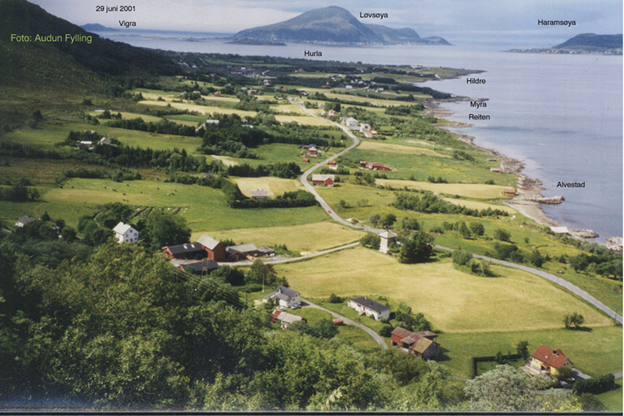
HILDRESTRANDA, NORWAY:
Knute Alvestad farm, lower right
Reiten and Hildremyr farms, upper middle
Hildre farms, upper right
In a booklet, Grytaslekta, which was printed around 1948, the Gryta family line is traced back for several centuries. Though the booklet contains a number of known inaccuracies, no doubt the general pattern of what is there is correct. A chart which summarizes the contents of that booklet is included here. It is from this Gryta family that WILHELMINE CAROLINE KARN MARTINUSDATTER HILDRE comes, for her mother was Berte Nilsdatter Gryta who married Martinus Nilsen Hildre. Martinus and Berte Nilsdatter Gryta Hildre had four daughters and three sons: Nikolina, Nil s, Wilhelmine, Andreas, Hans, Marta, and Anna. Of these, Wilhelmine and her two youngest sisters, Marta and Anna, were to emigrate to the United States and settle in the Petersburg area. In addition, several of her nieces and nephews, the children of her brothers, Andreas and Hans, also emigrated to the United States in time. Most of the other members of her family spent their lives in or near Brattvag, Norway.

BRATTVAG, NORWAY
Home of several Hildre families
Reiten History¶
Paternal Ancestry of Hans Knud Martinus Olsen Reiten¶
Ole Jetmundsen Helland (1745-1798) and Ingebor Jesperdatter (1745- )¶
Ole Jetmundsen Helland was born in 1745 and died in 1798 at age 53.
Ole married Ingebor Jesperdatter. Ingebor was born in 1745. They had a son: Jetmund Olsen.
Child of Ole Jetmundsen Helland and Ingebor Jesperdatter
Jetmund Olsen Synnaland was born in 1778 in Vatne, More ag Romsdal, Norway, was christened on 5 Jul 1778 in Vatne, More ag Romsdal, Norway, and died in 1847 at age 69.
Jetmund married Anna Martha Nilsdatter, daughter of Nils Olsen, on 30 Jan 1799 in Haram, More ag Romsdahl, Norway. Anna was born in 1789 and died in 1850 at age 61. They had six children: Niels, Nels Jetmundsen Synnaland, Jetmund Jetmundsen, Ole Jetmundsen, Ingeborg, and Berthe Martha.
Jetmund Olsen Synnaland (1778-1847) and Anna Martha Nilsdatter (1779-1850)¶
Jetmund Olsen Synnaland, son of Ole Jetmundsen Helland and Ingebor Jesperdatter, was born in 1778 in Vatne, More ag Romsdal, Norway, was christened on 5 Jul 1778 in Vatne, More ag Romsdal, Norway, and died in 1847 at age 69.
Jetmund married Anna Martha Nilsdatter, daughter of Nils Olsen, on 30 Jan 1799 in Haram, More ag Romsdahl, Norway. Anna was born in 1779 and died in 1850 at age 61. They had six children: Niels, Nels Jetmundsen Synnaland, Jetmund Jetmundsen, Ole Jetmundsen, Ingeborg, and Berthe Martha.
Children of Jetmund Olsen Synnaland and Anna Martha Nilsdatter
Niels Jetmunsen was born on 13 Oct 1799.
Nels Jetmundsen Synnaland Grytten was born on 29 Aug 1802.
Jetmund Jetmundsen Synnaland was born in 1805.
Ole Jetmundsen Alvestadreit was born on 3 Nov 1805 in Hildrestranda, More og Ramsdal, Norway and died in 1875 in Haram, More ag Romsdal, Norway at age 70.
Ole married Anne Oline Gurine Hansen on 5 Jun 1831in Haram, More ag Romsdal, Norway. Anne was born in 1811. They had one daughter: Helvig Andrine.
Ole next married Inger Marte Sjursdatter Aakre, daughter of Sjur Knudsen Aakre and Kari Hansdatter, on 19 Jul 1835 in Haram, More ag Romsdal, Norway. Inger was born on 16 Jan 1811 in Akre, Haram, Norway and died on 25 Jun 1853 at age 42. They had eight children: Knute Olsen, Ane Severine, Nels Olsen, Iver Olsen, Andreas Olsen, Hans Knud Martinus Olsen, Anna Oledatter, and Hellena Oledatter.
Ingeborg Jetmunsen was born on 5 Mar 1809.
Berthe Martha Jetmunsen was born on 10 Nov 1813.
Ole Jetmundsen Alvestadreit (1805-1875) and Anne Oline Gurine (1811- ) and Inger Marte Sjursdatter Aakre (1811-1853)¶
Ole Jetmundsen Alvestadreit, son of Jetmund Olsen Synnaland and Anna Martha Nilsdatter, was born on 3 Nov 1805 in Hildrestranda, More og Ramsdal, Norway and died in 1875 in Haram, More ag Romsdal, Norway at age 70.
Ole married Anne Oline Gurine Hansen on 5 Jun 1831 in Haram, More ag Romsdal, Norway. Anne was born in 1811. They had a daughter: Helvig Andrine.
Child of Ole Jetmundsen Alvestadreit and Anne Oline Gurine
Helvig Andrine Olsdatter was born on 24 Feb 1833.
Ole next married Inger Marte Sjursdatter Aakre, daughter of Sjur Knudsen Aakre and Kari Hansdatter, on 19 Jul 1835 in Haram, More ag Romsdal, Norway. Inger was born on 16 Jan 1811 in Akre, Haram, Norway and died on 25 Jun 1853 at age 42. They had eight children: Knute Olsen, Ane Severine, Nels Olsen, Iver Olsen, Andreas Olsen, Hans Knud Martinus Olsen, Anna Oledatter, and Hellena Oledatter.
Children of Ole Jetmundsen Alvestadreit and Inger Marte Sjursdatter Aakre
Knute Olsen Reiten was born about 1833 in Haram, More ag Romsdahl, Norway.
Knute married Anna. Anna was born in 1837.
Ane Severine Olsen was born on 8 May 1836.
Nels Olsen Reiten was born in 1843. Another name for Nels was Alvestad.
Iver Olsen Reiten was born in 1845 and died in 1910 at age 65.
Iver married Eli Enseth in 1868. Eli was born in 1844 and died in 1926 at age 82.
Andreas Olsen Reiten was born in 1847.
Hans Knud Martinus Olsen Reiten was born on 24 Dec 1850 in Hildrestranda, Sondmore, Norway, was christened on 9 Feb 1851 in Haram, Norway, died on 7 Nov 1934 in Petersburg, Nelson County, North Dakota at age 83, and was buried on 9 Nov 1934 in Petersburg, Nelson County, North Dakota.
Hans married Vilhelmine Caroline Karn Martinusdotter Hildre, daughter of Martinus Nilsen Hildre and Berte Nilsdotter Gryta, on 3 Sep 1876 in Hildrestranda, More ag Romsdahl, Norway. Vilhelmine was born on 27 Dec 1851 in Hildrestranda, More ag Romsdahl, Norway, was christened on 5 Jan 1852 in Haram, Norway, died on 11 Jul 1942 in Petersburg, Nelson County, North Dakota at age 90, and was buried on 15 Jul 1942 in Petersburg, Nelson County, North Dakota. They had eight children: Ole Hans Severin, Berthine "Tina" Enga Josephine, Martinus Knud Olaus, Hansine Kristine Helene, Hans Wilhelm, Emmeline Norah, Bella Petra Nicolina, and Nelson Anton.
Anna Oledatter Reiten was born in 1852.
Anna married Knute Alvestad.
Hellena Oledatter Reiten was born in 1854 in Hildrestranda, More ag Romsdahl, Norway.
Hellena married Albert Estbro.
Hans Knud Martinus Olsen Reiten (1850-1934) and Vilhelmine Caroline Karn Martinusdotter Hildre (1851-1942)¶
Hans Knud Martinus Olsen Reiten, son of Ole Jetmundsen Alvestadreit and Inger Marte Sjursdatter Aakre, was born on 24 Dec 1850 in Hildrestranda, Sondmore, Norway, was christened on 9 Feb 1851 in Haram, Norway, died on 7 Nov 1934 in Petersburg, Nelson County, North Dakota at age 83, and was buried on 9 Nov 1934 in Petersburg, Nelson County, North Dakota.
Hans married Vilhelmine Caroline Karn Martinusdotter Hildre, daughter of Martinus Nilsen Hildre and Berte Nilsdotter Gryta, on 3 Sep 1876 in Hildrestranda, More ag Romsdahl, Norway. Vilhelmine was born on 27 Dec 1851 in Hildrestranda, More ag Romsdahl, Norway, was christened on 5 Jan 1852 in Haram, Norway, died on 11 Jul 1942 in Petersburg, Nelson County, North Dakota at age 90, and was buried on 15 Jul 1942 in Petersburg, Nelson County, North Dakota. They had eight children: Ole Hans Severin, Berthine "Tina" Enga Josephine, Martinus Knud Olaus, Hansine Kristine Helene, Hans Wilhelm, Emmeline Norah, Bella Petra Nicolina, and Nelson Anton.
ADDTIONAL INFORMATION: Paternal Ancestry of Vilhelmine Caroline Karn Martinusdotter Hildre
Children of Hans Knud Martinus Olsen Reiten and Vilhelmine Caroline Karn Martinusdotter Hildre
Ole Hans Severin Reiten was born on 27 Mar 1877 in Hildrestranda, More ag Romsdahl, Norway, died on 14 Jun 1961 in Shevlin, Minnesota at age 84, and was buried in Jun 1961 in Petersburg, Nelson County, North Dakota.
Ole married Anna Josephine Hildre, daughter of Andreas Martinus Hildre, on 28 Nov 1905 in Crookston, Minnesota. Anna was born on 11 Mar 1885 in Hildestranda, Norway, died on 5 Aug 1970 in Billings, Montana at age 85, and was buried in Aug 1970 in Petersburg, Nelson County, North Dakota. They had five children: Harold Wilhelm, Arthur Bernhard, John Carl, Palmer Marvin, and Bernice Wilhelmine.
Berthine "Tina" Enga Josephine Reiten was born on 20 Nov 1878 in Hildrestranda, Sondmore, Norway, died on 4 Oct 1942 in Grand Forks, North Dakota at age 63, and was buried on 7 Oct 1942 in Petersburg, Nelson County, North Dakota.
Berthine married Ole Petersen Hildre, son of Peter Magnus Iversen and Karn Gurine Berentsdatter Flem, in Jun 1896 in Lakota, North Dakota. Ole was born on 18 Feb 1870 in Hildrestranda, Sondmore, Norway, died on 6 Oct 1952 in Petersburg, Nelson County, North Dakota at age 82, and was buried in Petersburg City Cemetery, Petersburg, North Dakota. They had five children: Peter Carl, Hartvig "Bo" Wilhelm, George Bert, Conrad, and Wilhelmina Karen.
Martinus Knud Olaus Reiten was born on 17 Jul 1881 in Hildrestranda, More ag Romsdahl, Norway, died on 10 Mar 1949 in Minneapolis, Minnesota at age 67, and was buried in Mar 1949 in Minneapolis, Minnesota.
Martinus married Marie Johnson, daughter of Lars Johnson and Thomine Johnson, on 14 May 1907. Marie was born on 18 Dec 1881 in Granite Falls, Minnesota, died on 20 Mar 1945 in Minneapolis, Minnesota at age 63, and was buried in Mar 1945 in Minneapolis, Minnesota. They had three children: Lyndon Harvey, Wilhelmine Caroline, and Therese Margaret.
Hansine Kristine Helene Reiten was born on 9 Dec 1883 in Hildestranda, Norway, died on 7 Feb 1966 in Michigan, Nelson, North Dakota at age 82, and was buried on 10 Feb 1966 in Petersburg, Nelson County, North Dakota.
Hansine married Martin O. Loken on 7 Feb 1913 in Petersburg, Nelson County, North Dakota. Martin was born on 6 Sep 1878 in Valdres, Norway, died on 6 Jun 1957 in Petersburg, Nelson County, North Dakota at age 78, and was buried on 8 Jun 1957 in Petersburg, Nelson County, North Dakota. They had one son: Lyndon Martin.
Hans Wilhelm Reiten was born on 15 Oct 1886 in Hildestranda, Norway, died on 25 Mar 1973 in Columbia Falls, Montana at age 86, and was buried on 27 Mar 1973 in Kalispell, Montana.
Hans married Lucy Isabelle Warner, daughter of Frank Warner and Estella Smith, on 30 Oct 1925 in Shelby, Toole, Montana. Lucy was born on 10 Aug 1892 in Buffalo Lake, Minnesota. They had one daughter: Shirley Wilhelmina.
Emmeline Norah Reiten was born on 14 Jan 1890 in Petersburg, Nelson County, North Dakota, died on 25 Jan 1952 in Petersburg, Nelson County, North Dakota at age 62, and was buried in Petersburg, Nelson County, North Dakota.
Bella Petra Nicolina Reiten was born on 17 Sep 1892 in Petersburg, Nelson County, North Dakota, died on 9 Jul 1967 in Grand Forks, North Dakota at age 74, and was buried in Petersburg, Nelson County, North Dakota.
Bella married Rudolph A. Gedstad on 20 Jun 1932 in Anoka, Minnesota. Rudolph was born on 24 Jan 1881 in Houston, Minnesota, died on 14 Jun 1954 in Petersburg, Nelson County, North Dakota at age 73, and was buried in Petersburg, Nelson County, North Dakota.
Nelson Anton Reiten was born on 5 Feb 1895 in Petersburg, Nelson County, North Dakota, died on 21 Nov 1964 in St. Cloud, Minnesota at age 69, and was buried on 24 Nov 1964 in Michigan, Nelson, North Dakota.
Nelson married Lillian Rose Andrews, daughter of Bartholemew Andrews and Rose Ann McCooey, on 10 Oct 1922 in Michigan, Nelson, North Dakota. Lillian was born on 15 Aug 1896 in Petersburg, Nelson County, North Dakota, died on 11 Aug 1955 in Grand Forks, North Dakota at age 58, and was buried on 13 Aug 1955 in Michigan, Nelson, North Dakota. They had ten children: Elizabeth Anne, Mary Catherine (Sister Paula O. S. B.), Robert Michael, Baby Boy, Patricia Rose, Kathleen Helen, Margaret Ellen (Sister Briget O.S.B.), Thomas Gerald, David Joseph, and Richard Matthew.
HANS KNUD MARTINUS OLSEN REITEN and WILHELMINE CAROLINE KARN MARTINUSDATTER HILDRE¶
This book begins with the life stories of HANS OLSEN and WILHELMINE MARTINUSDATTER HILDRE REITEN and continues with those of each of their children, of their children's children, and so on. In all, six generations of the Hans O. Reiten family appear in these pages.
REITEN, HANS KNUD MARTINUS OLSEN
b. 1850 December 24
d. 1934 November 7 (83 years old)
HILDRE, WILHELMINE CAROLINE KARN MARTINUSDATTER
b. 1851 December 27
d. 1942 July 11 (90 years old)
HANS KNUD MARTINUS OLSEN REITEN was born on December 24, 1850, in Hildrestranda, Sondmore, Norway, and was baptized in the parish of Haram on February 9, 1851. He was the son of farmer Ole Jetmundsen Alvestadreiten and wife Inger Sjursdatter Aakre. Hans's rank in the family is unknown, but he was not the oldest of the children of Ole and Inger.
Hans Knud Martinus Olsen, a fisherman and a farmer, must have received a good education in the public school system, for he was a great reader all his life and always eager to learn. Ingward Reiten describes the type of schooling that his father, Peter I. Reiten, the son of Hans's brother Iver, received in the 1880s:
From the age of seven until the age of ten or eleven, the children trudged a mile to school. There were no roads at that time, only footpaths across the moorland and swamps and meadows. The school year was only nine weeks, divided into three terms of three weeks each: one term was in mid-winter, one in the spring, and one in early fall. Though the instruction was largely religious, pupils with initiative might gather a variety of information, even if the teacher was not too talented or well educated. The boys from Hildrestranda would sit up in the loft and discuss what they had been reading. Norway was in the midst of a remarkable era of enlightenment at that time.
On September 3, 1876, at the age of 25, Hans married WILHELMINE CAROLINE KARN MARTINUSDATTER HILDRE, also of Hildrestranda, Sondmore, Norway, who was 24 years old. Wilhelmine was born on December 27, 1851 and was baptized in the parish of Haram on January 5, 1852. She was the second daughter and third child born to farmer Martinus Nilsen Hildre and wife Berthe Nilsdatter Gryta. She, too, must have been educated in the public schools of Norway, for she enjoyed reading all her life.
For the first eleven years of their married life, Hans and Wilhelmine lived on a small farm in a sheltered cove on a fjord in Hildrestrande, Haram, More og Romsdal. In Norway, the oldest son usually inherited his parents' property while the rest of the children had to find their livelihood elsewhere. Since Hans was not the oldest son, very likely this was not his father's farm. He probably had bought his farm, for on it he planted many trees and shrubs which are still there today. Three sons and two daughters were born to Hans and Wilhelmine while they were living on this farm. Since he had a growing family to provide for, Hans was a fisherman as well as a farmer.

Foreground: Hans O. Reiten farm in Hildrestranda, Norway
Hans and Wilhelmine must have been well aware of the people from Sondmore who were emigrating to America and settling in Minnesota and the Dakota Territory, for among those who had left were members of their families. Much earlier, Robert Flem had emigrated to Minnesota in 1866, and then, after returning to Sondmore and marrying, had emigrated a second time in 1882, this time to the Dakota Territory where he homesteaded southwest of Petersburg. In that same year, 1882, Petersburg was established as a town with a post office. In 1885, the son of Hans's brother, Knute, Ole K. Reiten, left Sondmore for North Dakota where in 1887, he homesteaded on two quarters of land south of Petersburg. In 1886, Wilhelmine's sister, Marta, and her husband Jonas Hildremyr, and their four children, emigrated to North Dakota where they homesteaded south of Petersburg. Her sister, Anna, also had emigrated to North Dakota and worked for a time in Lakota. In 1887, she married Ole B. Johnson and lived the rest of her life on their homestead nine miles south of Petersburg.
It was early in 1887 that Hans and Wilhelmine themselves left Norway with their five young children. Hans was 36 years old and Wilhelmine, 35. At the time they sailed for the United States, Hans, their youngest, was six months old; Ole, their oldest child, was ten years old. Martin, who was six at the time, recalled that on the trip they docked in Liverpool, England. The children there called to them in English, but they couldn't understand what they were saying. Nevertheless, they answered the English children in Norwegian.
The Reiten family landed in New York City in the spring of 1887 and set out for the Dakota Territory and the Petersburg area where others from Hildrestranda had preceded them; no doubt they traveled by railroad. They were in the Dakota Territory only a short time when Hans took out citizenship papers on June 13, 1887, for a person had to declare intent to become a citizen to be eligible for land under the Homestead Act. He became a naturalized citizen on October 31, 1896. Hans and Wilhelmine homesteaded on land about eight miles south of Petersburg. Apparently, they took out a tree claim, too, for Hans planted a mile-long grove of trees near his homestead. Many years later, his son Nels and his family were to live beside that grove of trees for twelve years while they raised turkeys.
ADDITIONAL INFORMATION: Petersburg, North Dakota
The first home of the Reiten family was either a dugout in a hillside or a sod house, or a combination of the two. There they endured many hardships. Ole's job in those early days was to twist hay to burn in the stove for heat. Some of the time they existed on bread and molasses. Hans often told about the severe winter their first year there when there were heavy blizzards and lots of snow. In the big blizzard of ' 87, they had to shovel snow into their house before they could shovel out to get outdoors. Then they had to tie a rope to the house and follow it to the barn to care for the cattle. During that blizzard, many people lost their lives and a lot of livestock was lost. It was the next year, 1888, that their fourth son, named Nelson for the county in which they lived, was born and died.
Before long, six more of Hans's nephews and one niece emigrated from Norway to the Petersburg area. Of his brother Knute's six children, two sons and one daughter came to join their oldest brother, Ole K. They were Andrew K. Reiten in 1887, Nels K. Reiten in 1893, and Kristine K. Reiten in 1903; later she married Robert Waag. Of his brother Iver's eight children, four sons emigrated to Petersburg: Ole I. Reiten and Peter I. Reiten in 1893, and Elias I. Reiten and Iver I. Reiten in 1896.
Others from Sondmore also arrived in Petersburg over the years: Martin Ekrom in 1888, Ole Sonderland and Peter I. Flem in 1892, Knut Slettebak in 1896, Martin Hildremyr in 1902, Lena Hildre in 1903, Carl Waag in 1907, Hans and Petrine Hildre with their daughter Laura in 1909. Soon Petersburg was well populated with Reitens and other immigrants from Sondmore, Norway.
The homestead of Hans and Wilhelmine proved to be poor land, so after living there for two or three years, Hans bought a farm three miles southwest of Petersburg which came to be known as the Hans O. Reiten farm. There he built good buildings including a large barn. He planted many trees and shrubs, and had a small orchard; later on, there was a hammock strung between two trees in the orchard in which his grandchildren loved to swing. They also had a buggy which Emma drove. Three more children were born to them while they were living on the farm.
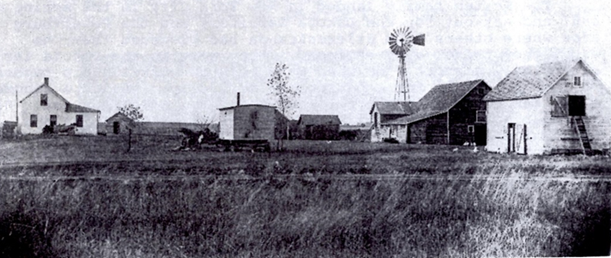
Hans O. Reiten farm, southwest of Petersburg 1915
In the early 1900s, Hans and Wilhelmine had a large house built in the southwest corner of Petersburg. This house had five bedrooms, three upstairs and two downstairs, as well as a big attic. Here they had some furniture and furnishings which they had brought with them from Norway, including Wilhelmine's dowry box, and cupboards for their beautiful cut-glass dishes. They also had a piano in the front room.

Hans and Wilhelmina about 1900
Therese recalls finding a pair of wooden shoes in the attic when she was small, and learning that these had been worn by her grandparents, Hans and Wilhelmine, to stamp out grain when they had farmed in Norway many years earlier. Over the years, this Reiten house saw many of the Reiten family come and go. It was the house to which the children and grandchildren of Hans and Wilhelmine returned for their annual summer visits. After they moved into this new house, they continued to farm their land south of town for some years. Hans, Emma, Bella, and Nels usually lived on the farm and ran it during the summer months. Around 1922, Ole Reiten and his family moved to this farm where they raised chickens until they moved to Minnesota in 1932. In 1947, Harvey Bales and his wife, Hilda Johnson who was Wilhelmine's niece, bought the farm.

Hans O. Reiten house Petersburg, ND
In March 1907, Hans and Wilhelmine, along with Bella and Nels, went to Tacoma, WA; in July, Christine and Emma joined them there. They all returned in September because, as the Petersburg Record reported, "the climate on the coast did not agree with Mrs. Reiten's health, she being troubled with rheumatism while out there. They say Petersburg is all right and are glad to get back." Very likely Nels was completing his eighth grade for part of the time in Tacoma, for he claimed that when he could not get along with his teacher in Petersburg, his parents moved to Tacoma so he could go to school there.

Bella, Emma, Peter Hildre
Hartvig Hildre, Nels about 1903
For over a year and a half during 1910-1911, Hans and Wilhelmine were in Norway. By following the reports of their activities in the Petersburg Record, it is possible to reconstruct something of this trip.
December 16, 1910: After Christmas, Hans Reiten and Nils K. Reiten and others will leave for eight months visit to "land of the midnight sun. "
January 27, 1910: Hans Reiten, wife and youngest child and Nels K. Reiten of Ryder expect to leave next Wednesday for Norway. We understand Hans will again take up his residence in the land of his nativity, while Nels K., after a few months there, will return.
February 3, 1910: Hans Reiten, wife and daughter Emma, and Nels K. Reiten and wife departed yesterday morning on their trip to Norway.
March 10, 1910: Robert Waag and bride, home from their honeymoon, will occupy the Hans Reiten residence in the western part of the village.
March 17, 1910: Hans Reiten and party arrived safely at their destination. Had a pleasant voyage.
July 20, 1911: Hans Reiten and party who have spent the past year at the old home in Norway arrived here last Saturday.
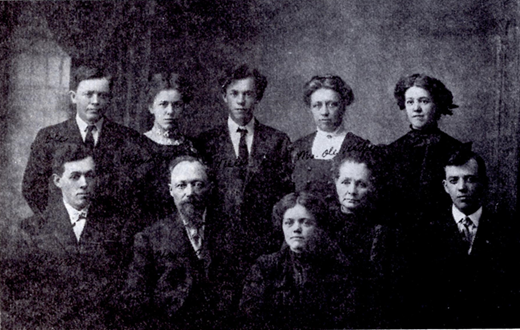
THE HANS O. REITEN FAMILY, 1910
Apparently they had intended to stay in Norway, for before they left Petersburg, they had a family picture taken as well as several smaller group pictures. In the photograph of the sons of Hans and Wilhelmine, Martin O. Loken is included. It is uncertain why he was included for he did not marry their daughter, Christine, until 1913.

Martin Loken , Ole, Nels,
Martin Reiten, Hans - 1910
At the time their parents left for Norway, Ole and Anna had three sons and were farming near Petersburg. Tina and Ole Hildre had four sons and were living in town where Ole was working in the Big Store; they had spent six months in Norway the previous year. Martin and Marie and Lyndon were living in FordviIle. Christine was teaching in Petersburg; in a postcard she mentions having to move upstairs, so apparently she and Nels, who was in high school, lived upstairs while the Robert Waags lived on the first floor of the Reiten home until their own new house was built. Hans was probably living on the farm, for the local paper reported the large potato crop he harvested in the fall of 1910. Bella was attending college in Grand Forks.
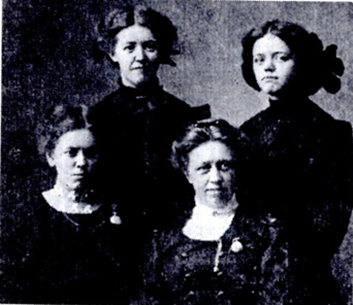
Emma, Bella, Christine, Tina 1910
In November 1910, Hans headed west to Wyoming, and Christine went to Norway to join her parents and Emma. While they were in Norway, the four of them had a photograph taken. It was in July 1911, that Hans and Wilhelmine, Christine and Emma, all returned from Norway.
There is some evidence that in 1914, when Hans was 63 years old and Wilhelmine was 62, they decided again to return to Norway to live. Again, they went there with Emma who was recovering from a breakdown; again, they stayed only a short time because of the threats of World War I. Though Norway remained neutral during the war, its merchant ships came under attack during the unrestricted submarine warfare. Norway was to lose about 2,000 seamen during the war.
For a year and a half, from November 1920 to May 1922, when they were in their early 70s, Hans and Wilhelmine again lived in Tacoma, WA, with Emma. This was probably their last extended trip. Wilhelmine wrote to her family in Petersburg in 1921; a translation of part of her letter follows:
. . . we are all Christian to date. Hans came from Edmonton and stopped, and he is here, and Bella is here also. There is no work to be had — same all over the west coast. Raining every day. Never rained every day in Norway.
In 1926, Hans and Wilhelmine celebrated the fiftieth anniversary of their wedding. The Petersburg Record noted the event:
A Golden Wedding was held in the Lutheran Church last Sunday afternoon in honor of Mr. and Mrs. Hans O. Reiten who fifty years ago that day were wed. All of their friends and neighbors gathered with the children and gave the honored couple a surprise. A very delicious lunch was served after the program. The Record joins in extending a hearty congratulations of the day and we hope to see Mr. and Mrs. Reiten to be as active and spry on their Diamond Wedding Day as they were on their fiftieth.
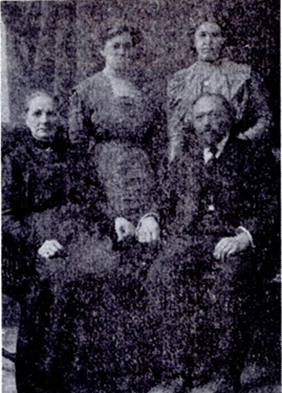
Christine and Emma, Hans and Wilhelmine – Norway, 1911
Hans was a fine gardener. He planted the boxwood hedge around his house in town as well as the one that still grows around the Petersburg Cemetery. Each summer he tended a thriving garden of flowers and vegetables and fruits, and in the backyard, raised a flock of chickens which laid eggs with bright orange yolks. He even raised his own tobacco. Pat Cervenka remembers when she was small, sitting on his lap and rubbing his beard with her hands. He had a very special grandpa tobacco smell. Wilma Code remembers him heating some of his homemade beer in a small frying pan and drinking it warm every morning.
Hans was also a great conversationalist. He did his best to learn English so he could converse and carry on his business and talk with his grandchildren, but most of his reading and talking was in his native tongue. He even tried to teach his grandchildren some Norwegian, but without too much success. It must have been a great joy for him and for Wilhelmine to have Therese, their granddaughter, learn Norwegian in high school and then write letters to them in their language.
Gamla Hans (old Hans), as he was affectionately called, loved to discuss world affairs; most of his information came from reading newspapers, and he had a retentive memory. Another of his favorite topics was geography which he knew well, for he had traveled a good deal. WiIma Code remembers how on many an evening, he would sit poring over maps spread over the dining room table. He loved to travel, if only in his mind. Ingward Reiten describes him as he would become involved in a conversation or discussion:
I can still see him when he had someone to talk with. He would stuff his pipe with the tobacco he had grown, light a match, hold it above his pipe while talking until it burnt his fingers, blow out the match, light another, and repeat the process all over again. If the subject was interesting, he never did get his pipe lit.

REITEN FAMILY REUNION, Ole Hildre farm, 1930
Back: George, Martin Loken, Conrad, Christine, Bella, Hans O., Anna, Emma, Lillie, Peter, Bernice, Marie, Wilma Hildre holding Mary Hildre, Tina, Ole Hildre, Ole Reiten, Martin Reiten, Wilhelmine, Hartvig
Front: Wilma Reiten holding Patty Rose, Betty with Margaret, Mary Catherine with Kathleen
Missing: Hans and Nels

Hans O. Reiten 1930s
Therese remembers sitting on the back porch with Hans watching the clouds in the west. He would tell her what each type of cloud meant - wind, rain, fair weather - for he could read clouds well from his years in Norway when he was a fisherman out on the ocean. He also enjoyed fishing and wasn't above playing tricks on people. Ingward Reiten remembers a fish story:
One time Hans was at a lake fishing. He and Agnes Ringstad were in one boat and Rev. Anderson was in another. Anderson hooked a fish which swam under the boats and became tangled in Hans 's hook. Hans pulled it in, took the fish off the line, and threw the line back. And so he was teased for stealing fish off the preacher's hook.
Hans died at his home in Petersburg of Bright's disease on November 7, 1934, at the age of 83. The following obituary appeared in the November 15, 1934, issue of the Petersburg Record:
HANS O. REITEN, another of our respected pioneers, passed away in his home Wednesday morning of last week at 5 0'clock, after a long illness.
Funeral was held Friday afternoon, interment being made in the Petersburg Cemetery. Services were held at the home and at the Lutheran Church with Reverends Rykken and Haatvedt officiating.
Hans O. Reiten was born near Aalesund, Norway, December 26, 1850, of parents Ole and Enge Reiten. He was baptized, confirmed, and married in the Ostnes Church in Haram.
He is survived by his wife, born Wilhelmine M. Hildre, eight children, Ole, who lives near Fosston, MN, Martin of Minneapolis, Hans of Shelby, MT, Mrs. Rudolph Gedstad of Peoria, IL, and Mrs. Ole Hildre,
Mrs. M. O. Loken, Emma, and Nels A. of Petersburg, 22 grandchildren, and three great grandchildren, and one brother in Hareide, Norway. Pallbearers were six grandsons, Peter, Hartvig, George, and Conrad Hildre, Lyndon and John Reiten.

Wilhelmine lived on in the big house with Emma after Hans died. During the winters of two school years in the mid-1930s, Nels and Lillie and their family lived in their home, too, so the children could go to school. When Rudolph Gedstad retired in 1940, he and Bella returned to Petersburg where they lived on the second floor of the Reiten home for at least part of the time.
Wilhelmine was a quiet, kind, gentle woman who spent her life caring for her children, her husband, and her home. She was always lonesome for Norway and learned very little English during her years in America. Her grandchildren remember her as a tiny woman who usually wore a white lace cap and would rock quietly in a rocking chair while the conversation in English flowed around her. Occasionally Emma or Bella or another of her children would turn to her and tell her in Norwegian, with the beautiful rhythms and cadences of that language, what was being said. She would listen, nod with a quiet, "Yah—da, " and continue her rocking. Betty Henry remembers that she sang from a black Norwegian hymnal in a "small " voice. And Therese remembers that she washed her hair every Friday.

Wilhelmine and Peter Hildre, her first grandchild 1909
Wilhelmine was always solicitous and loving with her grandchildren. She knew how to comfort them with soothing murmurs and soft pats. She wanted to be with them but found it difficult to converse with them. As she grew older, she grew quieter and was content just to be with her family.
A letter written by Emma, probably around 1940, ends with a poignant note. She wrote that Wilhelmine had said "she carried both Ole and Hans to daapen (baptism) herself - and I am telling her I think she was pretty brave then. 'Yes,' says she, ‘I used to be but not now. ‘ ”
Wilhelmine died quietly as she had lived, at her home in Petersburg on July 11, 1942, at the age of 90. Both she and Hans are buried in the Petersburg cemetery.
ADDITIONAL INFORMATION: Petersburg City Cemetery
Emma continued to live in the Reiten home, which was then "Emma 's House, until her death in 1952. At times, Bella and Rudolph lived there, too. When it became Bella's house after Emma's death, she did not live there regularly after Rudolph 's death in 1954. The house, which was owned by Hans after Bella died in 1967, stood vacant for some years until it was demolished in 1976 or 1977 so that Walter Ohnstad could build a new home on the site.
Hans and Wilhelmine were the parents of four sons and four daughters; one son was born and died in 1888. They had 23 grandchildren and 56 great grandchildren. The life stories of all of these are in this book.
OLE HANS SEVERIN REITEN¶
b. 1877 March 27, in Hildrestranda, Norway
m. 1905 November 28, ANNA JOSEPHINE HILDRE (1885-1970), in Crookston, MN
children: 1906 September 6 HAROLD WILHELM REITEN (d. 1940)
1908 February 16 ARTHUR BERNHARD REITEN (d. 1971)
1910 January 26 JOHN CARL REITEN (d. 1991)
1913 October 18 PALMER MARVIN REITEN (d. 1998)
1916 November 26 BERNICE WILHELMINE REITEN (NIELSEN) (d. 1967)
d. 1961 June 14, 84 years old
BERTHINE ENGA JOSEPHINE REITEN (HILDRE)¶
b. 1878 November 20, in Hildrestranda, Norway
m. 1896 June, OLE PETER HILDRE (1878-1942), in Lakota, ND
children: 1898 June 3 PETER CARL HILDRE (d. 1976)
1899 September 23 HARTVIG WILHELM (BO) HILDRE (d. 1975)
1902 June 26 GEORGE BERT HILDRE (d. 1960)
1907 May 26 CONRAD HILDRE (d. 1999)
1914 May 13 WILHELMINA KAREN HILDRE (CODE) (d. 1989)
d. 1942 October 4, 62 years old
MARTINUS KNUD OLAUS REITEN¶
b. 1881 July 17, in Hildrestranda, Norway
m. 1907 May 14, MARIE JOHNSON (1881-1945)
children: 1909 May 23 LYNDON HARVEY REITEN (d. 1968)
1911 July 17 WILHELMINE CAROLINE REITEN (REITEN) (d. 1962)
1912 November 10 THERESE MARGARET REITEN (MEELBERG) (d. 1986)
d. 1949 March 10, 67 years old
HANSINE KRISTINE HELENE REITEN (LOKEN)¶
b. 1883 December 9, in Hildrestranda, Norway
m. 1913 February 7, MARTIN O. LOKEN (1878-1957), in Petersburg, ND
children: 1921 August 5 LYNDON MARTIN LOKEN (d. 1979)
d. 1966 February 7, 82 years old
HANS WILHELM REITEN¶
b. 1886 October 15, in Hildrestranda, Norway
m. 1925 October 30, LUCY ISABELLE WARNER (1892-1990), in Shelby, MT
children: 1926 July 30 SHIRLEY WILHELMINA REITEN (SPENCER) (d. 2011)
d. 1973 March 25, 86 years old
EMMELINE NORAH REITEN¶
b. 1890 January 14, in Petersburg, ND
d. 1952 January 25, 62 years old
BELLA PETRA NICOLINA (GEDSTAD)¶
b. 1892 September 17, in Petersburg, ND
m. 1932 June 20, RUDOLPH A. GEDSTAD (1881-1954), in Anoka, MN
d. 1967 July 9, 74 years old
NELSON ANTON REITEN¶
b. 1895 February 5, in Petersburg, ND
m. 1922 October 10, LILLIAN ROSE ANDREWS (1896-1955), in Michigan, ND
children: 1923 August 9 ELIZABETH ANNE RETTEN (HENRY) (d. 2004)
1924 October 26 MARY CATHERINE REITEN (S. Paula, OSB) (d. 2019)
1927 February 23 PATRICIA ROSE REITEN (CERVENKA)
1929 January 19 KATHLEEN HELEN REITEN (d. 1977)
1929 January 19 MARGARET ELLEN REITEN
1932 December 13 THOMAS GERALD REITEN (d. 2006)
1934 June 30 DAVID JOSEPH REITEN (d. 2016)
1937 January 28 RICHARD MATTHEW REITEN
d. 1964 November 21, 69 years old
Reiten Family Photos¶
PHOTOS: Reiten Photos
THREE YOUNGEST CHILDREN, BORN IN AMERICA


REITEN FAMILY GATHERING, 1933
back: Marie, Martin, Lillie holding Tom, Christine, Nels, Bella, Hans, Emma
front: Lyndon, Betty, Margaret, Kathleen, Patty Rose, Shirley, Mary Catherine